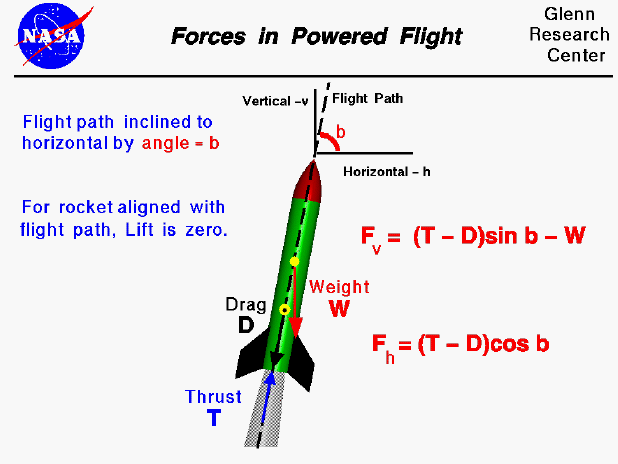

The forces on a model rocket change dramatically in both magnitude and direction throughout a typical flight. This figure shows the forces on a rocket during the powered portion of the flight following liftoff. During the powered portion of the flight, the rocket is subjected to the forces of weight, thrust, and aerodynamics (lift and drag) just like an aircraft. Remember that lift is defined to be the aerodynamic force that is perpendicular to the flight direction, and drag is defined to be the force opposed to the flight direction. Comparisons of aircraft and rockets show that:
Considering the forces on the model rocket, the weight (W) is always directed toward the center of the earth. If the axis of the rocket is perfectly aligned with the flight path, the thrust (T) is along the direction of the flight path. The lift is perpendicular to the flight path by definition and, due to the symmetry of the rocket, will normally have a magnitude of zero. If the axis of the rocket is not aligned with the flight path, generated lift stabilizes the rocket and brings it back into alignment. By definition, the drag (D) is directed along the flight path. The amount of drag depends on several factors, including the shape and size of the rocket and the square of the rocket velocity, which changes throughout the powered portion of the flight.
During powered flight, the flight path will normally be inclined to the local vertical and horizontal because of weather cocking. We can then use trigonometry (which you learn in high school), to break the forces into horizontal and vertical components using the inclination angle - (b) . The net horizontal force (Fh) on the rocket is the thrust minus the drag times the cosine (cos) of the inclination angle to the horizontal:
Fh = [T - D] * cos b.
The net vertical force (Fv) is the thrust minus the drag times the sine (sin) of the inclination angle minus the weight:
Fv = [T - D] * sin b - W.
The acceleration, velocity, and location of the rocket during powered flight can be determined at any time during the flight by applying Newton's Second Law of Motion, making some simplifying assumptions, and using some math. The thrust of the model rocket engine changes during the initial portion of the powered flight, but it has been designed to remain fairly constant during ascent.
Go to...
byTom
Benson
Please send suggestions/corrections to: benson@grc.nasa.gov